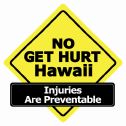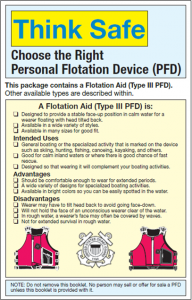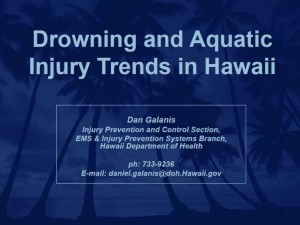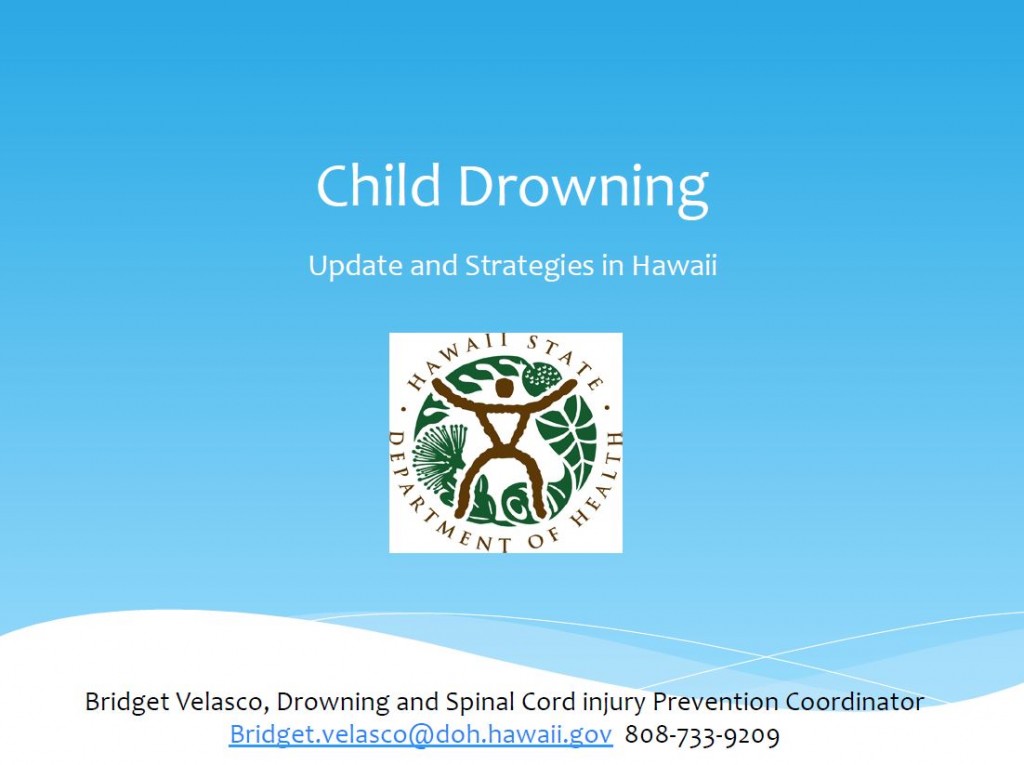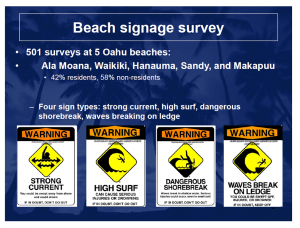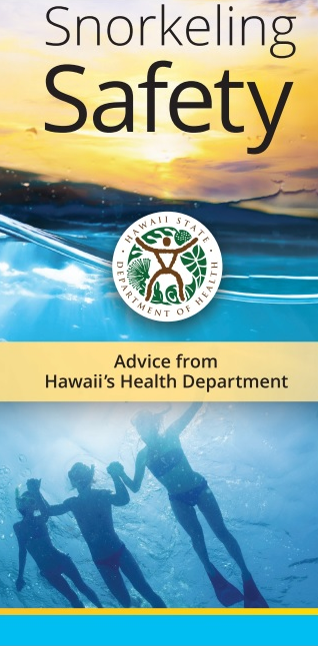
Drowning Prevention Basics
 Drowning is the 5th leading cause of fatal injuries in Hawaii, with an average of nearly 40 deaths a year. Drowning is the only injury cause for which non-residents comprise a majority of victims (53%), and their inclusion increases the average annual number of deaths to 83. Hawaii had the 2nd highest resident drowning fatality rate among all 50 states from 2013 to 2017, behind only Alaska. Among non-residents during this time period, drownings were the 3rd leading cause of any type of death, behind heart disease and cancer, and the leading cause of injury-related death, ahead of suicide, falls, motor vehicle crashes, and other causes. Compared to non-residents (183), there were slightly less resident drowning deaths during this time period (176), mostly while swimming, free diving, and unknown activity. Most non-resident drowning deaths occurred while snorkeling, swimming and unknown activity. The rate of fatal ocean drowning for non-residents in Hawaii is about eight times higher than for residents. Kauai has the highest ten-year rate (/100,000) of total (resident and non-resident) fatal ocean drownings (82.5), followed by Maui (64.6), Big Island (51.8) and Oahu (27.2).
Drowning is the 5th leading cause of fatal injuries in Hawaii, with an average of nearly 40 deaths a year. Drowning is the only injury cause for which non-residents comprise a majority of victims (53%), and their inclusion increases the average annual number of deaths to 83. Hawaii had the 2nd highest resident drowning fatality rate among all 50 states from 2013 to 2017, behind only Alaska. Among non-residents during this time period, drownings were the 3rd leading cause of any type of death, behind heart disease and cancer, and the leading cause of injury-related death, ahead of suicide, falls, motor vehicle crashes, and other causes. Compared to non-residents (183), there were slightly less resident drowning deaths during this time period (176), mostly while swimming, free diving, and unknown activity. Most non-resident drowning deaths occurred while snorkeling, swimming and unknown activity. The rate of fatal ocean drowning for non-residents in Hawaii is about eight times higher than for residents. Kauai has the highest ten-year rate (/100,000) of total (resident and non-resident) fatal ocean drownings (82.5), followed by Maui (64.6), Big Island (51.8) and Oahu (27.2).
For every fatal drowning, it is estimated that 13 non-fatal drownings occur, some of which may be associated with long term disability. In addition to the pain and suffering, the “comprehensive effects of drowning include the economic loss (victim’s productivity loss and the expenses relating to the event) and the value of lost quality of life associated with the death or injury.” (Lifeguard Effectiveness: A Report of the Working Group, CDC 2001). The United States Lifesaving Association estimates that that one percent of the total rescues made by lifeguards would have resulted in a drowning death in the absence of lifeguards. In 2015 alone, county ocean lifeguards in the state of Hawaii reported performing over 4,000 ocean rescues.
There were 49 drowning deaths to children 0-18 years old during the ten-year period of 2005-2014. This made drowning the 2nd leading cause of injury-related mortality among children under 18 years of age over that time period, behind only deaths among automobile occupants (54), and ahead of suicides (45), suffocations (mostly (34 deaths) among infants), homicides (29), and pedestrian (27) and motorcycle/moped crashes (14). 21 of these deaths were in the ocean/saltwater, 15 in a swimming pool, 7 in bathtubs, 2 in rivers/streams, and 4 unknown or other water environment.
Common questions
Q: How can I lower my risk of drowning?
A: When entering the water, there is always a drowning risk. However, “Most drownings are preventable through a variety of strategies, one of which is to provide lifeguards in public areas where people are known to swim and to encourage people to swim in those protected areas. Some estimates indicate that the chance of drowning at a beach protected by lifeguards can be less than one in 18 million. There is no doubt that trained, professional lifeguards have had a positive effect on drowning prevention in the United States.” -Lifeguard Effectiveness: Report of the Working Group (2001) https://www.cdc.gov/homeandrecreationalsafety/water-safety/pubs.html
Q: What other things can I do to help keep myself and my family safe?
A: Listed is a summary of drowning contributory factors and preventive actions: (Drowning: Prevention, Rescue and Treatment 2014)
Contributory Factors:
- currents
- waves
- off-shore winds
- pre-existing disease
- underwater entanglement
- bottom surface gradient and stability
- water transparency
- impeded visibility
- lack of parental supervision
- poor or inadequate equipment
- overloading of boats
- overestimation of skills and lack of local knowledge
- cold
- alcohol use
Preventive and Management Actions:
- Public education regarding hazards and safe behaviors
- Regulations that discourage unsafe behaviors
- Continual adult supervision
- Restriction of alcohol provision
- Provision of properly trained and equipped lifeguards
- Provision of rescue services
- Access to emergency response
- Local hazard warning notices
- Development of rescue and resuscitation skills among general public and user groups
- Wearing of adequate lifejackets when boating
Q: Where can I find information about which beaches are safe?
A: The Hawaii Beach Safety website gives Hawaii beach users timely and accurate information for choosing a beach destination appropriate to their ocean skill level. Use this site in conjunction with consultation with the lifeguard on duty to make an aware and informed decision before entering the water.
Q: Which beaches have lifeguards?
A: The Hawaii Beach Safety website provides detailed information about lifeguarded beaches on each island, including
a map of beach locations.
Q: What’s the “Best” personal flotation device (PFD)?
A: In terms of risk of drowning, the best Personal Flotation Device (PFD) is the one that matches your needs!!
Some of the choices are a better for certain situations than others, and therefore the choices are explained in the “Think Safe” PFD pamphlet that is sold with every US Coast Guard approved PFD. By reading the pamphlet, you can understand how to safely have fun on the water.
Myth: Swimming lessons prevent drowning.
Truth: Learning to swim may only reduce the risk of drowning. Drowning is caused by many factors. The American Academy of Pediatrics (AAP) recommends parents use layers of protection such as:
- All parents and caregivers should be trained in infant child CPR.
- Closely supervising children at all times when in or around any body of water. Proper care of a young non-swimmer requires the supervising adult to be within an arm’s length and provide “touch supervision”.
- Installing a four-sided fence around swimming pools. Compared with no fencing, installation of 4-sided fencing that isolates the pool from the house and yard has been shown to decrease the number of pool-immersion injuries.
- When swimming in natural bodies of water or other sites accessible to the public, swim in designated swim areas with lifeguards present.
Myth: Active-drowning persons show signs of distress by calling out for help.
Truth: People who are actively drowning are unable to speak. Speaking is a function secondary to breathing. If someone cannot breathe, they cannot speak. Active drowning persons will alternately sink below and then rise above the water’s surface. While they are above the surface, they will exhale and inhale before they sink again. There is not enough time to cry out.
Myth: Active-drowning persons show signs of distress by waving their arms for help.
Truth: Someone in the active-drowning stage often presses down on the surface and tries to use it as leverage to get their mouth out to breathe. Onlookers might see arm movements that appear to be flapping the water not waving in the air.
Drowning Prevention Details
For data on drowning, please refer to:
- The Databook: Injuries in Hawaii – Drowning Report 2007-2011 (PDF 1 MB)
- The updated 2008-2012 Summary on Drowning (PDF 19 KB) for more detail.
Drowning and Aquatic Injury Trends in Hawaii
An overview of ocean incidents in Hawaii, presentation by Dan Galanis.
Please contact epidemiologist [email protected] for more information.
An overview of child drowning in Hawaii, presentation by EMSIPSB office.
Please contact epidemiologist [email protected] for more information.
In 2010, the Injury Prevention Control Section (IPCS) in partnership with the City and County, Ocean Safety Division led a statewide needs assessment that included a review of best practices for drowning prevention, in-depth telephone interviews with ten key stakeholders (i.e., representatives of organizations involved in prevention efforts, and potential partners), and two strategic planning sessions with partners from the community and the visitor industry. With assistance from the Injury Prevention Advisory Committee (IPAC), the information gathered through this process was used to develop and prioritize the drowning prevention recommendations for the Hawaiʻi Injury Prevention Plan. For more detail, please refer to the drowning prevention recommendations in the 2018-2023 Hawaiʻi Injury Prevention Plan (HIPP)
One of the recommendations was the establishment of a statewide task force to work with the issue of drowning and water related injuries. The Drowning and Aquatic Injury Prevention Advisory Committee was formed in Fall 2015. The Advisory Committee is comprised of representatives from roughly one dozen agencies (see list below) that have influence over the prevention of drowning in Hawaii.

Drowning and Aquatic Injury Prevention Advisory Committee
Advisory Committee Mission
The Advisory Committee’s mission is to reduce the incidence of drowning and water related spinal cord injuries in Hawaii through networking, education, advocacy and resource development. The Advisory Committee, in conjunction with the Task Force, will establish, implement, evaluate and disseminate best practices for drowning and spinal cord injury prevention in the state of Hawaii.
Advisory Committee Composition
The composition of the Advisory Committee shall include:
- Hawaiian Lifeguard Association
- City and County Ocean Safety
- County Fire Department
- Hawaii Military
- Hawaii Coast Guard
- City and County Parks and Recreation
- Department of Land and Natural Resources
- Hawaii Tourism Authority
- Private Non-Profit Swimming Lesson / Jr. Lifeguard
- Injury Prevention Advisory Committee
- Hawaii Board of Education
- Other agencies as recommended
Evaluation
In 2009, the Injury Prevention and Control Section (IPCS) surveyed over 500 beach goers on O‘ahu, both residents and visitors, to assess the impact of four types of beach warning signs: strong current, high surf, dangerous shore break, and waves breaking on ledge. Results showed that about half of those surveyed saw the signs, and among those, 66% thought the signs would influence their behavior.
- Statewide
- Hawaiian Lifeguard Association
- Hawai‘i Coast Guard
- Hawai‘i Military
- Hawai’i State Department of Health – NEUROTRAUMA SUPPORTS
- Hawai‘i State Department of Land and Natural Resources
- Hawai‘i Tourism Authority
- Injury Prevention Advisory Committee
- Kama‘aina Kids
- Na Kama Kai
- Swimming Pool Association of Hawai‘i
- University of Hawai‘i School of Ocean and Earth Science and Technology
- Visitor Aloha Society
- Honolulu
- City and County of Honolulu Department of Parks and Recreation
- City and County of Honolulu Ocean Safety and Lifeguard Services Division
- Hawai’i Aquatics Academy
- North Shore Lifeguard Association
- Ocean Safety ‘Ohana
- YMCA of Honolulu
- Hawai‘i
- County of Hawai‘i Department of Research and Development
- County of Hawai‘i Fire Department
- County of Hawai‘i Ocean Safety
- County of Hawai‘i Parks and Recreation Division
- Kaua‘i
- County of Kaua‘i Ocean Safety
- County of Kaua‘i Parks and Recreation Division
- Kaua‘i Lifeguard Association
- Kaua‘i Visitor Bureau
- Maui
- County of Maui Fire Department
- County of Maui Ocean Safety
- County of Maui Parks and Recreation Division
- Maui Visitor’s Bureau
Local Resources
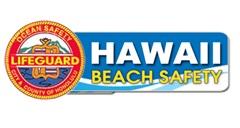 The Hawaii Beach Safety website gives Hawaii beach users timely and accurate information for choosing a beach destination appropriate to their ocean skill level. Use this site to help you make an aware and informed decision based on the latest information. When you get to the beach, be sure to check with the lifeguards for problems and hazards that may affect your safety.
The Hawaii Beach Safety website gives Hawaii beach users timely and accurate information for choosing a beach destination appropriate to their ocean skill level. Use this site to help you make an aware and informed decision based on the latest information. When you get to the beach, be sure to check with the lifeguards for problems and hazards that may affect your safety.
 |
Respect Our Ocean & Stay Beach Safe |Hawaii Ocean Safety
hioceansafety.com Before you go to the beach in Hawaii, check out this useful guide with important things you can do to respect our ocean and stay beach safe. |
Snorkeling is one of the most popular ocean activities to do in Hawaii, but it can also be the most dangerous. More Hawaii visitors drown while snorkeling than during any other activity. If you intend to go snorkeling in Hawaii, you should be an experienced ocean swimmer familiar with the risks and dangers associated with high surf, strong currents, and waves breaking in shallow water. In addition to the things you should always to do stay safe in the ocean, there are many other precautions you should take when snorkeling to further reduce your risk of drowning or injury.
Download a printable Snorkeling Safety brochure by clicking on the brochure image. Also available in Traditional Chinese, Korean and Japanese. 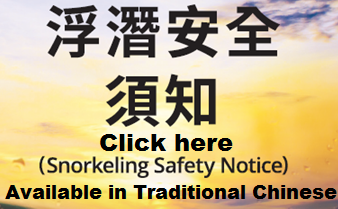
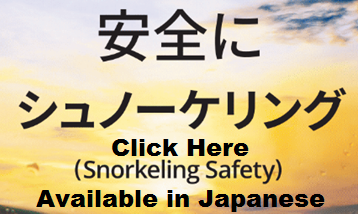
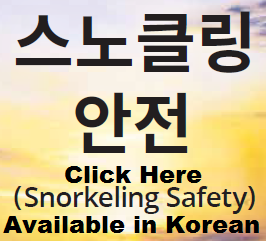

National Resources
Children Safety Network (CSN) on Drowning Prevention
The CSN is providing this special resource of information on water safety. This resource contains information about water safety laws; prevention strategies and programs; evaluations of the effectiveness of lifeguards and swimming lessons to support safe swimming practices; policies and campaigns to encourage water safety; and safety barrier restrictions and other safety guidelines.
Federal Legislation
On December 17, 2007, the Virginia Graeme Baker Pool and Spa Safety Act was signed into law. This important child safety law became effective in December 2008 and strives to:
- Enhance the safety of public and private pools and spas,
- Encourage the use of layers of protection,
- Reduce child drowning in pools and spas (nearly 300 each year involving children younger than five),
- Reduce the number of suction entrapment incidents, injuries and deaths, and
- Educate the public on the importance of constant supervision of children in and around water.
U.S. Consumer Product Safety Commission (CPSC) created Pool Safely: Simple Steps Save Lives, a national public education campaign to reduce childhood drowning, non-fatal submersions and entrapments in public swimming pools and spas. The campaign carries out the requirements of the Virginia Graeme Baker Pool & Spa Safety Act (P&SS Act), federal legislation mandating new requirements for public pools and spas, including a public information campaign. Pool safely is designed to raise public awareness, promote industry compliance and improve safety at pools and spas.
Tips for Swimmers & Guardians
American Academy of Pediatrics (AAP): Safety Technical Report—Prevention of Drowning
The AAP continues to support swimming lessons for children 4 years old and older without physical or developmental disabilities. A Position Statement
Center for Disease Control: Safety Tips for Swimmers and Boaters
Whether it’s an uneven lake bottom or drop-off, rip current or unexpected hazardous weather, swimmers in natural water settings need to be aware of the dangers and take special precautions to stay safe. Scroll to mid-page.
American Academy of Pediatrics: Sun and Water Safety Tips
Keep your family safe this summer by following these tips from the American Academy of Pediatrics (AAP).
National Drowning Prevention Alliance: Open Water Safety Tips
For Swimmers and Boaters
USLA’s Top Ten Beach and Water Safety Tips
Learning to swim is the best defense against drowning. The United States Lifesaving Association created 10 tips to prevent drowning.
United States Lifesaving Association’s (USLA) Spinal Injury Prevention at the Beach
The United States Lifesaving Association created Spinal Injury Avoidance Tips.
U.S. Consumer Product Safety Commission (CPSC): How to plan for the unexpected?
The information below can help parents and caregivers provide young children with the protection they deserve.
Pool Readiness: Safety Equipment & Design
U.S. Consumer Product Safety Commission Guidelines for Pool Barriers
This U.S. Consumer Product Safety Commission (CPSC) handbook offers guidelines for pool barriers that can help prevent most submersion incidents involving young children. The CPSC standards are not mandatory requirements. Therefore, the Commission does not endorse these guidelines as the sole method to minimize pool drowning of young children.
Consumer Product Safety Commission: Safety Barrier Guidelines for Residential Pools
This U.S. Consumer Product Safety Commission (CPSC) booklet offers guidelines for pool barriers that can help prevent most submersion incidents involving young children. This handbook is designed for use by owners, purchasers, and builders of residential pools, spas, and hot tubs.
Boating Education
U.S. Coast Guard’s Reference Guide to State Boating Laws
The U.S. Coast Guard’s Boating Safety Division created a database guide, supplied by the states and collectively updated during 2007.
Search for U.S. Coast Guard’s Boating Education Classes in Hawaii
U.S. Coast Guard Auxiliary boating courses provide instruction to boaters at all levels, from the fundamental to the advanced. Classes are taught by experienced and knowledgeable instructors committed to the highest standards of the U.S. Coast Guard.
Personal Flotation Devices
U.S. Coast Guard’s recommended Personal Flotation Devices, Use, Wear & Care
The Coast Guard is working with the PFD community to revise the classification and labeling of PFDs. When completed, this information will be updated and hopefully be somewhat easier to understand. Meanwhile, spending a few minutes to understand the many options available to find a PFD that you’re willing to wear could mean the difference between life and death for you or a loved one.

